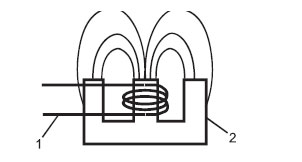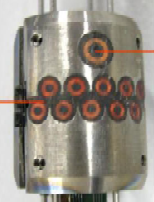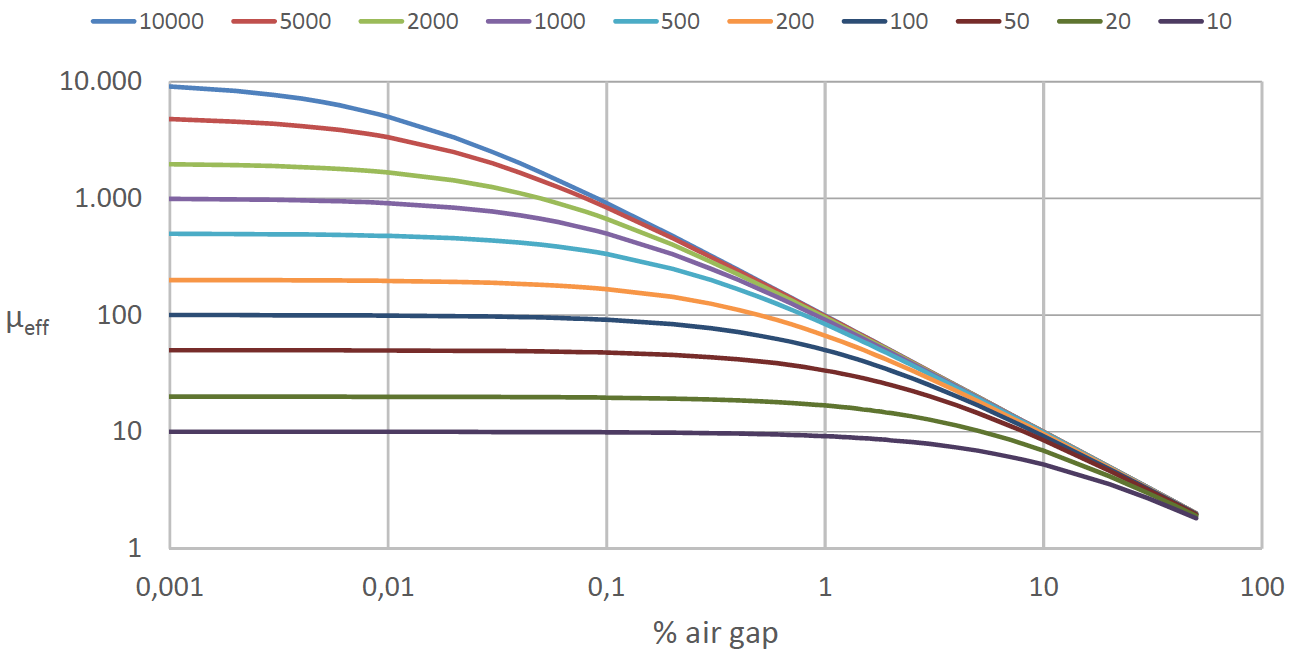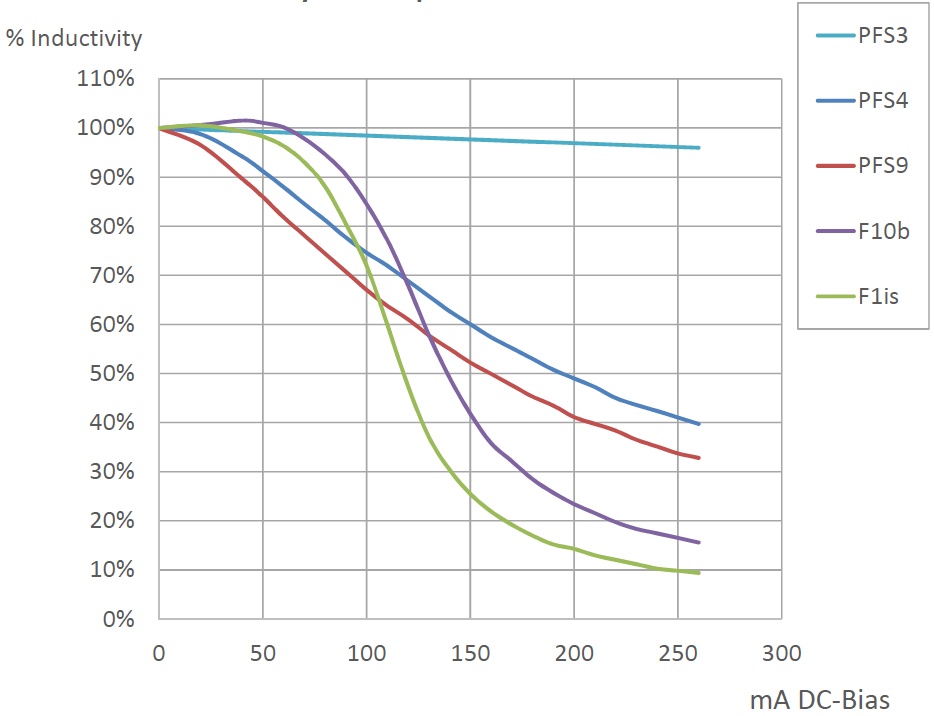Topics
- Common exploited properties of Ferrites
- Forming fields
- Shaping ferrites
- Contacting coils
- Permeability μ changes with
- frequency | temperature
- air gap | excitation level
- DC bias/magnetic fields | mechanical forces
Properties and applications of Ferrites 1
- “collecting” and shaping of magnetic fields
➤ sensors, antennas, transponders - Increasing “inertia” of electric current
➤ chokes, noise suppression, filters, delay lines - Increase magnetic coupling of conductors
➤ transformers, converters, storage chokes,
impedance matching
Antennas and Sensors

Metal detection and recognition

- source: IFM
Inductive proximity switch:
Directing and focussing magnetic field

- source: http://eddycation.de/
Non destructive Material testing:
- Material sorting (e.g. Coin recognition)
- Material thickness (e.g. Coin recognition)
- Crack detection and depth determination
- Imaging of material faults
Dry pressing of ferrites

Cross-section through a sintered pot core
pressed part before sintering
powder column in the mould before pressing

uneven densification
➤ strains and cracks,
particularly at the lines
where portions of
different thicknesses meet
Crack formation in pressed ferrites

Density differences during powder pressing
➤ differing densification in thinner and thicker
areas of the part can cause
crack formation at the intersections


Examples for injection molded parts

Isotropic 3D-cube antenna 9x9x9mm
- monolytic, hollow ferrite
- high Q-factor, high sensitivity
- reduction in material and weight
smallest customer specific designs
- wall thickness ≥ 0,22mm,
- volume ≥ 1mm3
- tolerances down to +-1%
SMD transponder coils
- high Q-factor, high sensitivity
- high reliabilty in vibration und drop tests
Ferrite production at NEOSID
| mixing oxides | main components Fe Mn Ni Zn |
|---|---|
| pre sintering | homogenization and formation of the ferrite structure |
| milling | creating a very fine powder |
| compounding | mixing ferrite powder and binder |
| injection moulding | 1 to 28 cavities |
| barrel finishing | rounding edges, removing flash |
| sintering | in air or under controlled oxygen concentration |
| annealing | establishing an optimum domain structure |
| grinding | tight tolerance, flat surface, round, thread grinding, CNC milling of prototypes |
| coating | e.g. parylene, self-locking screw cores, metallization |
| Inspection | electrical, geometrical |
Contacting Technologies

Wire wound terminal

Metal pin terminal

Metallized core terminal
Common competitors Metallisations

Dipping
Dipping in silverpaste, burning in and plating
➤ low quality factor caused by eddy currents in end faces
➤ Nickel-Zink-Ferrite only

single layer PVD
selective deposition of e.g. silver
➤ poor adhesion
➤ dissolves during soldering, does not withstand thermocompression
Metallisation from NEOSID

3-layer PVD
selective deposition of 3 layers where whished for, no burning in
➤ reduction of eddy currents
➤ works on Manganese- and Nickel-Zink-Ferrite
➤ good adhesion
➤ withstands soldering and thermocompression



automated 100 % optical inspection




Soft magnetic Ferrites
NiZn-Ferrites
- μi from 10 to 2.000
- high Q between 0 and 100 MHz
- large electrical resistance
- higher Tc
- sintering in air
MnZn-Ferrites
- μi from 700 to 20.000
- high Q between 0 and 1 MHz
- small electrical resistance
- lower Tc
- sintering under controlled atmosphere only
Influence of Frequency

μ‘ = permeability
μ‘‘ = losses
Q = μ‘/μ‘‘
For lower losses (higher Q) at higher frequencies chose lower μ material
Influence of Temperature

Medium and small μi
- Very small temperature drift

High μ
- Almost linear temperature drift
(can be compensated)
Very high μ materials

Very unstable μ
➤ troublesome compensation

Sources: TDK-Catalogue
Only for very low
frequency applications
Influence of air gap

Air gap: Fraction of magnetic path not
running in ferrite material
- μeff vs. % air gap for varying μi

Sensing Coils are mainly open magnetic circuits
with a large air gaps (≈ 50% for a pot core).

- source: IFM
The larger the air gap, the less difference in μeff
remains between high and medium μ materials.
Influence of excitation level

Initial permeability μi is
μ measured at low excitation
levels (B < 0,5 mT)
μa changes at high excitation
levels
With open magnetic circuits
μeff << μa
B = μeff*μo*H is rather small
and sensors usually work in
stable μ regime
Influence of DC-Bias and external Fields
- Inductivity of transponder-Coil vs. DC-Current

Permeability decreases with
application of
- DC-bias
- external magnetic fields
ferrites stay stable up to a certain
level and than drop quite fast
Higher μ ferrites suffer earlier
Composites PFS4 and PFS9
drop earlier but slower
Composite Material PFS3 is
extremely stable
up to > 1000 mT
Impact of strong magnetic fields and excessive mechanical force
3 ferrite material classes
NiZn-ferrites F2a to F100b
- Some impact, extremely slow recovery
- complete recovery can be reached only through thermal annealing
- a-Types (like F2a) are less sensitive
MnZn-ferrites F02 and F08
- impact, but fast recovery
NiZn-ferrites F1ib, F1is, F5is and Composite Materials
- hardly any impact
Composite materials
- Hardly any impact
- distributed air gap ➤ lower permeability
- Saturation flux density > 1000 mT for PFS3
- Tighter mechanical tolerances
- Easy to machine
What do you need ?
High Q value at your frequency
- wide range of ferrite materials F02 to F100
- number in name gives maximum frequency in MHz
for which high Q is still achieved (02 is 0.2 MHz)
Excelent temperature stability
- materials F2 to F100 are your choice
High temperature applications
- Materials with Curie Temperature ranging
from 150 to 600 °C are available
Highest excitation levels
Large DC-Bias or strong external magnetic fields
- PFS3 will do your job
Temporary Magnetic or mechanical stress
- F1ib does not remember the torture
Smallest sizes, Customized shapes
Complicated geometries, Design for automation
- Ceramic Injection Moulding of ferrites
turns your vision into products
Contacting Pads, Shielding
Thermal compression of wire ends
- Selective metallization of ferrites serves your needs
Medical applications
- Parylene coating gives you coverage
You do not like cables and plugs
- Wireless data and power transfer gets rid of cables
Wireless power and data transfer
Rotating scanner system



Energy transfer from primary to secondary side.
Bi-directional data transfer

Properties and applications of Ferrites 2
Less common thought of properties of soft magnetic ferrites:
- Magnetostriction
➤ Ultrasonic actuators and sensors, “invisible speakers” - Lossy interaction with fields from MHz to some GHz
➤ Inductive Heating, selective microwave heating - Colour and magnetics
➤ Copier powder - DC-Magnetization
➤ Switchable mechanical forces
Tell us your requirements – we will develop the fitting solution for you!
Have we aroused your interest? Then get in touch with us.
Download
PDF „Ferrites for sensor applicatons – design and properties“





